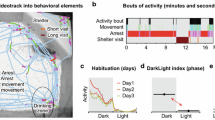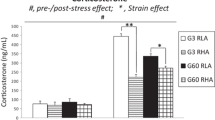Abstract
The interest of biometrical geneticists in the genetic architecture of behavior is explained with reference to the additive, dominance, and epistatic components of variation and their relation to evolutionary pressures. For one phenotype, escape-avoidance conditioning inRattus norvegicus, a fairly complete description of its genetic architecture has been gradually built and the major conclusions from four studies of this phenotype are reported: a selection study initially demonstrated the presence of large amounts of additive genetic variation and produced phenotypically extreme lines needed for later work; a diallel cross provided the opportunity for detailed examination of the dominance effects; a triple test cross permitted a similar examination of epistatic effects; and finally, another triple test cross using wild rats provided a confirmatory first attempt to test the assumption that a wild population's genetic architecture did not differ markedly from that found in laboratory populations. In relating the genetic findings to the evolutionary significance of behaviors in the escape-avoidance paradigm, it is argued that interspecific comparisons might play a major role.
Similar content being viewed by others
References
Angus, J. (1974). Changes in the behaviour of individual members of a Drosophila population maintained by random mating.Heredity 33:89–93.
Bignami, G. (1965). Selection for high and low rates of conditioning in the rat.Anim. Behav. 13:221–227.
Bignami, G., and Bovet, D. (1965). Expérience de sélection par rapport à une réaction conditionée d'évitement chez le rat.C. R. Acad. Sci. 260:1239–1244.
Breese, E. L., and Mather, K. (1960). The organisation of polygenic activity within a chromosome inDrosophila. II. Viability.Heredity 14:375–399.
Broadhurst, P. L. (1979). The experimental approach to behavioral evolution. In Royce, J. R., and Mos, L. P. (eds.),Theoretical advances in behavior genetics, Sijthoff and Noordhoff International, Alphen aan der Rhijn.
Broadhurst, P. L., and Bignami, G. (1965). Correlative effects of psychogenetic selection: A study of the Roman high and low avoidance strains of rats.Behav. Res. Ther. 2:273–280.
Broadhurst, P. L., and Jinks, J. L. (1961). Biometrical genetics and behavior: Re-analysis of published data.Psychol. Bull. 58:337–362.
Fisher, R. A. (1928). The possible modification of the response of the wild type to recurrent mutations.Am. Nat. 62:115–126.
Fisher, R. A. (1958).The Genetical Theory of Natural Selection, 2nd ed., Dover, New York.
Fulker, D. W. (1966). Mating speed in maleDrosophila melanogaster: A psychogenetic analysis.Science 153:203–205.
Fulker, D. W., and Broadhurst, P. L. (1971). A diallel study of the effects of genotype-environment interaction on activity and learning in the rat.Heredity 27:480 (abstract).
Fulker, D. W., Wilcock, J., and Broadhurst, P. L. (1972). Studies in genotype-environment interaction. I. Methodology and preliminary multivariate analysis of a diallel cross of eight strains of rat.Behav. Genet. 2:261–287.
Henderson, N. D. (1964). A species difference in conditioned emotional response.Psychol. Rep. 15:579–585.
Henderson, N. D. (1968). Genetic analysis of acquisition of a conditioned fear in mice.J. Comp. Physiol. Psychol. 65:325–330.
Hewitt, J. K. (1980). A note on the test of direction of dominance in the triple test cross in the presence of genotype × environment interaction.Heredity 45:293–295.
Hewitt, J. K., and Fulker, D. W. (1981a). Using the triple test cross to investigate the genetics of behavior in wild populations. I. Methodological considerations.Behav. Genet. 11:23–35.
Hewitt, J. K., and Fulker, D. W. (1981b). Using the triple test cross to investigate the genetics of behavior in wild populations. II. Escape-avoidance conditioning in Norway rats (submitted for publication).
Jinks, J. L., Perkins, J. M., and Breese, E. L. (1969). A general method of detecting additive, dominance and epistatic variation for metrical traits. II. Application to inbred lines.Heredity 24:45–57.
Kearsey, M. J., and Barnes, B. W. (1970). Variation for metrical characters in Drosophila populations. II. Natural selection.Heredity 25:11–21.
Kearsey, M. J., and Jinks, J. L. (1968). A general method of detecting additive, dominance and epistatic variation for metrical traits. I. Theory.Heredity 23:403–409.
King, J. A. (1977). Behavioral comparisons and evolution. In Oliverio, A. (ed.),Genetics, Environment and Intelligence, North-Holland, Amsterdam.
Linney, R. (1977). Polymorphism at two loci through selection for linear metrical deviation.Heredity 38:379–390.
Mather, K. (1941). Variation and selection of polygenic characters.J. Genet. 41:159–193.
Mather, K. (1960). Evolution in polygenic systems.Acad. Naz. Lincei 47:131–152.
Mather, K. (1973).Genetical Structure of Populations, Chapman and Hall, London.
Mather, K. (1974). Non-allelic interactions in continuous variation of randomly breeding populations.Heredity 32:414–419.
Mather, K. (1979). Historical overview: Quantitative variation and polygenic systems. In Thompson, J. N., and Thoday, J. M. (eds.),Quantitative Genetic Variation, Academic Press, New York.
Mather, K., and Harrison, B. J. (1949). The manifold effect of selection.Heredity 3:1–52.
Mather, K., and Jinks, J. L. (1971).Biometrical Genetics, 2nd ed., Chapman and Hall, London.
Mowrer, O. H. (1960).Learning Theory and Behavior, Wiley, New York.
Owen, V. A. (1972). The inheritance of two-way avoidance behaviour in rats: An introduction to the triple-test cross, Unpublished master's dissertation, University of Birmingham, Birmingham.
Owen, V. A. (1979). The genetic control of shuttle avoidance behaviour in laboratory rats: A triple-test cross investigation, Unpublished doctoral dissertation, University of Birmingham, Birmingham.
Sheppard, P. M. (1967).Natural Selection and Heredity, Hutchinson, London.
Virk, D. S., and Jinks, J. L. (1977). The consequences of using inadequate testers in the simplified triple test cross.Heredity 38:237–251.
Wilcock, J., and Fulker, D. W. (1973). Avoidance learning in rats: Genetic evidence for two distinct behavioral processes in the shuttle box.J. Comp. Physiol. Psychol. 82:247–253.
Wilcock, J., Fulker, D. W., and Broadhurst, P. L. (1981). Analysis of two-way escapeavoidance conditioning measures from a diallel cross of eight strains of rats.Behav. Genet. 11:339–358.
Author information
Authors and Affiliations
Rights and permissions
About this article
Cite this article
Hewitt, J.K., Fulker, D.W. & Broadhurst, P.L. Genetics of escape-avoidance conditioning in laboratory and wild populations of rats: A biometrical approach. Behav Genet 11, 533–544 (1981). https://doi.org/10.1007/BF01070008
Received:
Accepted:
Issue Date:
DOI: https://doi.org/10.1007/BF01070008




